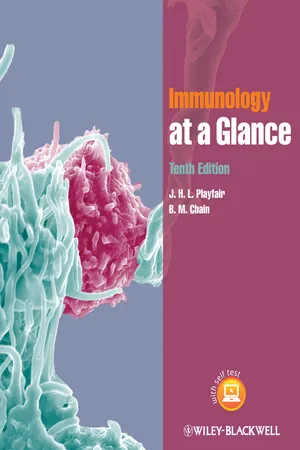
- English
- ePUB (mobile friendly)
- Available on iOS & Android
Immunology at a Glance
About this book
Immunology at a Glance provides a user-friendly overview of the body's defence mechanisms. Ideal from day one of a medical, biomedical or life science course, the text begins with a basic overview of both adaptive and innate immunity, before progressing to applied immunological concepts, which look at what happens when things go wrong, and how, in clinical medicine, each body system can be affected by immunity.
Each double-page spread corresponds to a typical lecture and diagrammatically summarises core concepts in immunology, through accessible schematic diagrams on left-hand pages, with key points concisely summarised on the right-hand page. There are also self-assessment essay questions so you can test your knowledge.
New for this 10th edition:
- Thoroughly updated and reorganised chapters offer greater clarity and easier understanding for those new to the subject
- New chapters on cytokine receptors and 'Immunology in the Laboratory'
- A completely re-written section on autoimmunity
- A brand new companion website featuring self-assessment questions and PowerPoint slides of images from the book, ideal for teaching and revision at www.ataglanceseries.com/immunology
Immunology at a Glance is the ideal companion for anyone about to start a new course in immunology and will appeal to medical and biomedical science students. Perfect for exam preparation, it provides the concepts and frameworks you need to succeed in your exam.
Frequently asked questions
- Essential is ideal for learners and professionals who enjoy exploring a wide range of subjects. Access the Essential Library with 800,000+ trusted titles and best-sellers across business, personal growth, and the humanities. Includes unlimited reading time and Standard Read Aloud voice.
- Complete: Perfect for advanced learners and researchers needing full, unrestricted access. Unlock 1.4M+ books across hundreds of subjects, including academic and specialized titles. The Complete Plan also includes advanced features like Premium Read Aloud and Research Assistant.
Please note we cannot support devices running on iOS 13 and Android 7 or earlier. Learn more about using the app.
Information
1
The Scope of Immunology

Non-Self
Infection
External Defences
Innate Resistance
Adaptive Immune Response
Vaccination
Grafting
Autoimmunity
Hypersensitivity
Immunosuppression
2
Innate and Adaptive Immune Mechanisms

Table of contents
- Cover
- Table of Contents
- Companion Website
- Title
- Copyright
- Preface
- Acknowledgements
- Note on the Tenth Edition
- How to Use This Book
- Further Reading
- List of Abbreviations
- 1 The Scope of Immunology
- 2 Innate and Adaptive Immune Mechanisms
- 3 Recognition and Receptors: The Keys to Immunity
- 4 Cells Involved in Immunity: The Haemopoietic System
- 5 Receptors of the Innate Immune System
- 6 Complement
- 7 Acute Inflammation
- 8 Phagocytic Cells and the Reticuloendothelial System
- 9 Phagocytosis
- 10 Evolution of Recognition Molecules: The Immunoglobulin Superfamily
- 11 The Major Histocompatibility Complex
- 12 The T-Cell Receptor
- 13 Antibody Diversification and Synthesis
- 14 Antibody Structure and Function
- 15 Lymphocytes
- 16 Primary Lymphoid Organs and Lymphopoiesis
- 17 Secondary Lymphoid Organs and Lymphocyte Traffic
- 18 Antigen processing and presentation
- 19 The Antibody Response
- 20 Antigen – Antibody Interaction and Immune Complexes
- 21 Cell-Mediated Immune Responses
- 22 Tolerance
- 23 Cell Communication and Cytokines
- 24 The Cytokine Network
- 25 Immunity, Hormones and the Brain
- 26 Antimicrobial Immunity: a General Scheme
- 27 Immunity to Viruses
- 28 HIV and AIDS
- 29 Immunity to Bacteria
- 30 Immunity to Fungi and Ectoparasites
- 31 Immunity to Protozoa
- 32 Immunity to Worms
- 33 Immunodeficiency
- 34 Harmful Immunity: a General Scheme
- 35 Allergy and Anaphylaxis
- 36 Immune Complexes, Complement and Disease
- 37 Chronic and cell-mediated inflammation
- 38 Autoimmune Disease
- 39 Transplant Rejection
- 40 Immunosuppression
- 41 Immunostimulation and Vaccination
- 42 Cancer Immunology
- 43 Immunity and Clinical Medicine
- 44 Investigating Immunity
- 45 Immunology in the Laboratory
- 46 Out of the Past: Evolution of Immune Mechanisms
- 47 Into the future: immunology in the age of genomics
- Self-Assessment Questions
- Answers
- Appendix I: Comparative Sizes
- Appendix II: Landmarks in the History of Immunology
- Appendix III: CD Classification
- Index
- End User License Agreement